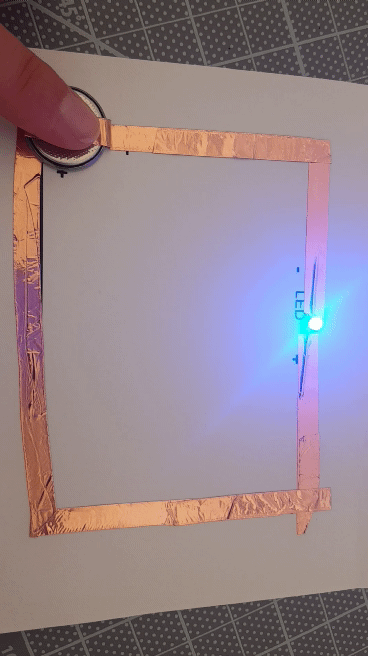
A piece of “electric” paper (i.e. conductive copper tape shaped into a circuit with an LED light and a battery).
A question we’ve been asking since this institute began is, “What is a book?” This question has been almost impossible to answer since Day 1. The thing most of us think of when we think of a book are pages bound together by glue inside of a hard binding and ordered in a particular sequence. Turns out that thing is actually just a codex, a type of a book, but not the book. Books can be scrolls. Books can be webpages. Books can be a stream of audio. Books are, at its simplest form, containers of information, and at its most complex, an art form where the content – the words on the inside of the book – mirror its form – the way it’s bound, presented, and delivered. But I think what struck me today is that books must also be accessible containers of information. A book is only as good as its ability to be understood. What’s the point in having information available if people can’t understand it or explore it?
I’ve been studying literacy for a while now, and I’ve struggled not to replicate a variety of literacy myths in my writing. One of the biggest myths about literacy is that literacy will inherently set everyone free. If everyone just learns to read silently and with great focus, then we will all be able to advance ourselves and accomplish more in our society. While I’ve intellectually understood the problems with this particular myth for a while (one way of reading does not guarantee “success” for anyone), emotionally, I’ve struggled to counter it because of my own personal attachments to silent reading from a paperback novel. Books are, perhaps, one of the most important things to me. They’ve given me solace in times of desperation. They’ve offered me levity in moments of sorrow. They’ve offered me tickets to places I’ll probably never get to visit. I’m, of course, writing in platitudes here, but I’ve long struggled as an educator to divorce my own longings for books from what I know is often best for my students who have different minds, backgrounds, and experiences from me.
It is not my job to convince someone to love reading as much as I do: my job is to get someone access to information so that they can do whatever it is that drives them to do the awesome things that they want in the world. I’m not merely a supplier of skills, of course, but (I hope) that I’m a supplier of experiences that make people feel like they are capable of making changes in ways that they perhaps could not have fully realized before their schooling. Literacy is about empowerment, and the acquisition of new knowledge, not just developing skills for the sake of developing skills.
So, recognizing that books can take so many different forms has been revelatory to me, not only on the level of seeing how different media and modes could help people learn material differently, but also on the level of recognizing that different books must take different forms in order to accommodate the diversity of thinkers and bodies in our world.
We focused today on a discussion of disability and learned some major tenets of disability theory from Mara Mills at NYU. As someone who has only had exposure to disability studies through principles like Universal Design for Learning, I was glad to learn more about how disability scholars have struggled to reconcile medical definitions of disability, which tend to focus on a person’s defects, with the social definitions of disability, which tends to focus more on how bodies interact in built environments that fail to accommodate diversities in abilities. Many disabled people have reclaimed the term “disability” to take on an activist mission of creating inclusive spaces for everyone, regardless of their bodies. While I don’t think we can abandon a medical definition of what a disability is (we still have to acknowledge physiology, after all), I think it is provocative and important to explore the construction of our physical and social spaces to acknowledge how our vision for moving the world is, really, quite limited to certain kinds of bodies that move in certain ways.
But I think the moment where things really clicked for me was when Dr. Mills described how, in the early 20th century, literacy became narrowly defined to refer to the silent reading of printed, alphabetic text. Indeed, starting in 1929, the Encylopedia Brittanica listed that an “inability to read” was “the greatest handicap” a person could suffer. Around 1900, eyesight was measured not by counting seeds or identifying objects in images, but instead, by reading letters off of a vision chart and identifying printed words. The U.S. Census began to count blind individuals not by their inability to see light, but their inability to read newsprint, thus institutionalizing the importance of silent, printed reading as the main form of literate engagement in the U.S.
This is all incredible to me because it shows that a.) the assumption that literacy primarily means reading from a printed book is a relatively recent phenomenon and b.) that our institutionalized definitions of literacy ignore the many kinds of literacies that people must acquire to understand information in the world.
Recognizing that our own definitions of what it means to communicate and communicate well are grounded in longer histories and media ecologies is fascinating. As this week goes on, I’m hoping to put even more of it together!
